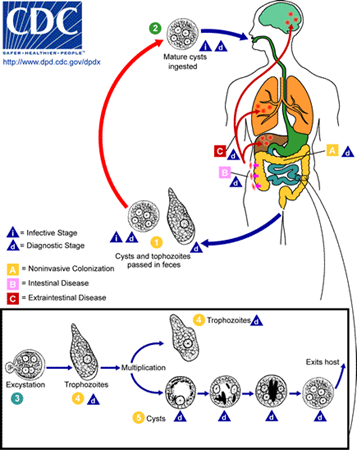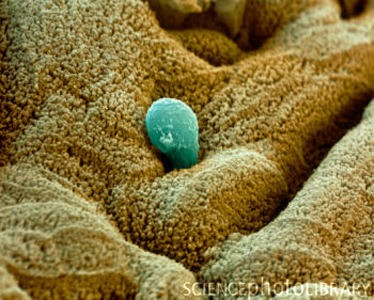Quick Facts
|
Amebiasis is a parasitic disease caused by a protozoan parasite Entamoeba histolytica. The most common manifestations of E. histolytica infection are dysentery and liver abscesses. E. histolytica usually resides in the large intestine, and can persist there for months or years and cause an asymptomatic intestinal infection. However, clinical amebiasis occurs when the parasite penetrates the colon wall, causing ulcerative colitis, or disseminates into other organs, most commonly the liver, leading to abscess formation. Current therapy for amebiasis relies on metronidazole, which was first introduced in 1959. Potential resistance of E. histolytica to metronidazole is an increasing concern and clinical failures have been linked to other metronidazole-resistant protozoa. Standard treatment with metronidazole requires three doses per day for 10 days and is accompanied by frequent side effects. In addition, metronidazole has no effect on intraluminal carriage, so follow-up treatment with a second, luminal active drug such as paromomycin is recommended to prevent prolonged carriage and excretion. Therefore, a shorter, less toxic, and more effective therapy is needed.
What is it?
E. histolytica has a simple life cycle that usually consists of an infective cyst stage and a multiplying trophozoite stage. Transmission of the infection occurs via ingestion of cysts in faecally contaminated food, water, or hands. Once ingested, excystment occurs in the small bowel; the resulting trophozoites migrate to the large intestine where they multiply by binary fission, and form new cysts, thus completing the replication cycle. In many cases, the trophozoites remain confined to the intestinal lumen of individuals who are asymptomatic carriers, passing cysts in their stool. In some patients the trophozoites invade the intestinal mucosa, or through the bloodstream, extraintestinal sites such as the liver, brain, and lungs, with resultant pathologic manifestations.

Where does it occur?
 Amebiasis occurs worldwide, but it is most common in tropical areas with crowded living conditions and poor sanitation. Africa, Mexico, parts of South America, and India have significant health problems associated with this disease. The World Health Organization estimates up to 50 million invasive infections by this parasite worldwide annually, resulting in about 70,000 deaths each year. Infection with E. histolytica is the fourth leading cause of death and the third leading cause of morbidity due to protozoan infections worldwide. E. histolytica has been listed by the NIH as a category B priority biodefense pathogen in the United States due to its low infectious dose and potential for dissemination through compromised food and water supplies.
Amebiasis occurs worldwide, but it is most common in tropical areas with crowded living conditions and poor sanitation. Africa, Mexico, parts of South America, and India have significant health problems associated with this disease. The World Health Organization estimates up to 50 million invasive infections by this parasite worldwide annually, resulting in about 70,000 deaths each year. Infection with E. histolytica is the fourth leading cause of death and the third leading cause of morbidity due to protozoan infections worldwide. E. histolytica has been listed by the NIH as a category B priority biodefense pathogen in the United States due to its low infectious dose and potential for dissemination through compromised food and water supplies.

 Scanning electron micrograph of Entamoeba histolytica (blue) invading the lining of the large intestine (colon). Credit: SciencePhotoLibrary
Scanning electron micrograph of Entamoeba histolytica (blue) invading the lining of the large intestine (colon). Credit: SciencePhotoLibrary